You found our list of important remote work statistics.
Remote work statistics are facts and figures that deal with virtual offices and work from home. These numbers come from studies and surveys of professionals in various industries. This information is important because remote work plays an increasingly important role in modern business. Looking at the data helps employers understand trends and embrace changing work landscapes.
For more resources on WFH, check out our ultimate guide to remote work, list of top work from home books, and tips for managing virtual teams. Plus these top remote work trends.
Here are the numbers.
Remote work statistics [free to cite]
You can use this data in any format, including social media, blogs, and presentations.
Please cite the source as TeamBuilding and link to https://teambuilding.com/blog/remote-work-statistics.
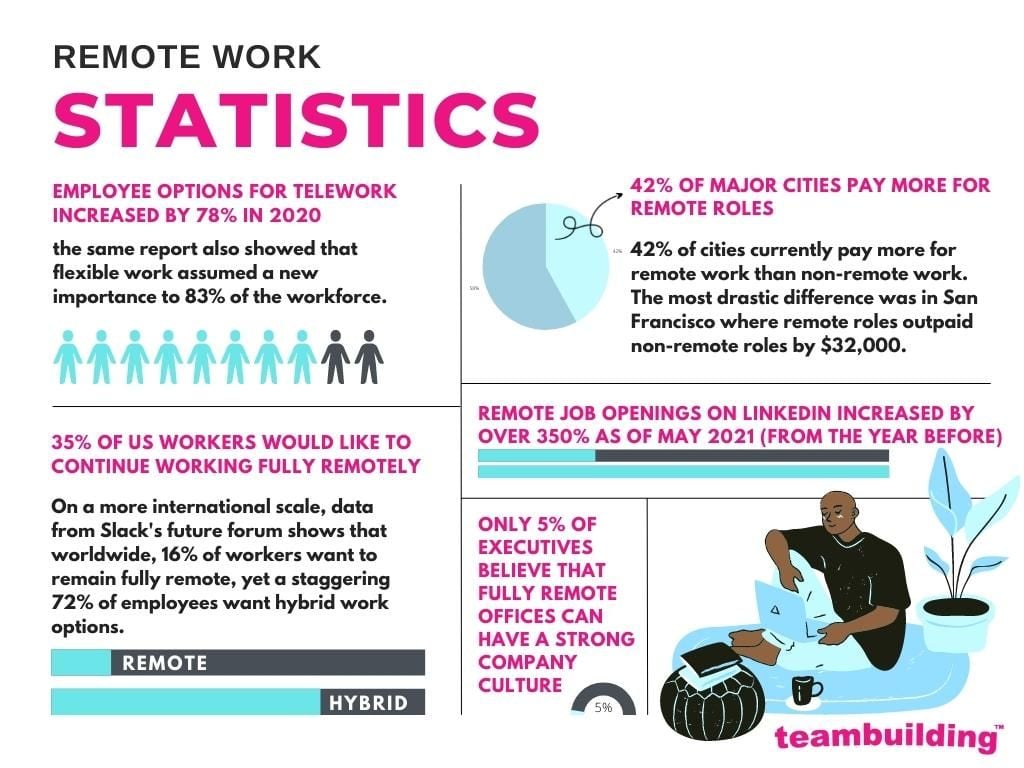
1. Over half of Americans believe that their industry can work from home productively
Data from the LinkedIn Workforce Confidence Index shows that 55% of US respondents think that their industry can work effectively from home. When examining digital fields like finance, marketing, and software, that percentage jumps to 75%.
The sector that is least confident in its ability to work virtually is retail, with less than a third of respondents seeing long term sustainability in remote work.
Unsurprisingly, according to Pew Research Center, adults with higher levels of education and income are more likely to self-report that their work is doable from home.
2. At least 56% of US workers could work remotely
Research from Global Workplace Analytics confirms the confidence workers have in the plausibility of WFH by revealing that 56% of the non-self-employed US workforce has jobs that are conducive to remote work at least some of the time. This figure translates into roughly 75 million workers. In 2005, that number was closer to 40%, and it is likely that percentage will continue to grow as technology advances and work norms shift.
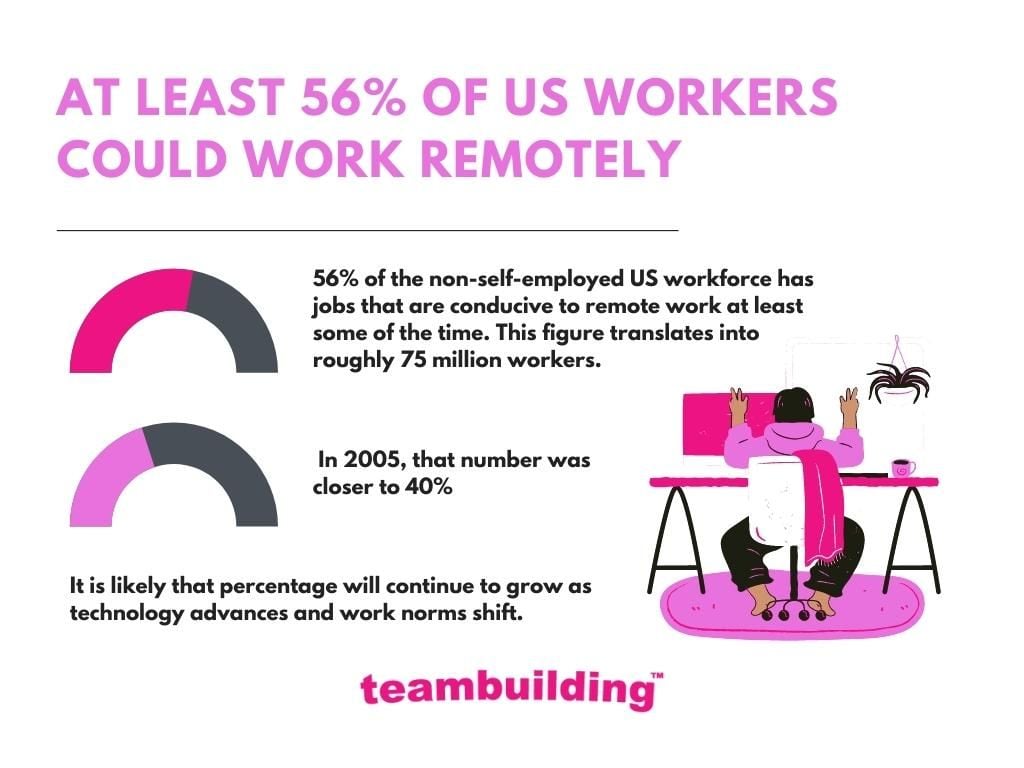
Want some free team building tools?
$49 value (100% free)
- 100+ fully tested icebreaker questions
- 24+ themed Bingo generators
- 5+ PDFs (including the 8% Rule)
- 2024 team building calendar
- and more...

Enter your email for instant access
3. 36.2 million Americans will be remote by 2025
An economic report by Upwork found that as of late 2020, 41.8% of Americans were still working remotely. That same study projected that by the year 2025, 36.2 million Americans would be virtual workers, a 16.8 million worker increase from pre-pandemic times.
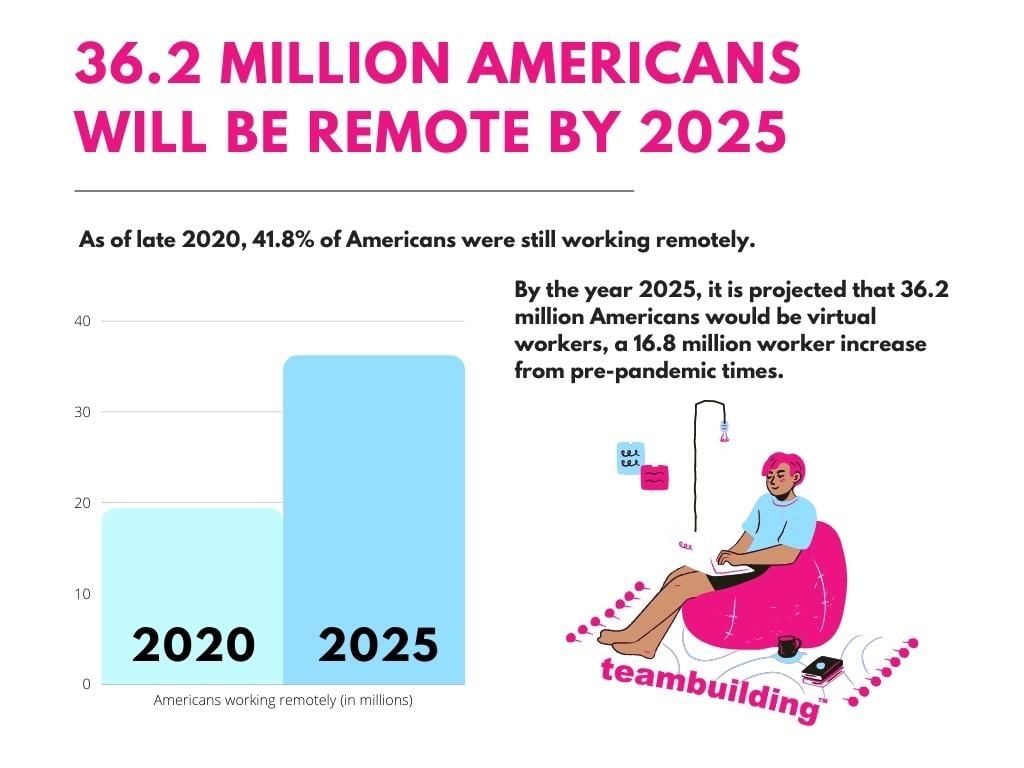
4. 82% of employers expect to allow remote work options post-pandemic
A survey run by research and consulting firm Gartner revealed that 82% of executives expected to offer the ability to work remotely at least some of the time post-pandemic.
Many employers expect to implement hybrid work arrangements as the predominant work model.
5. Employee options for telework increased by 78% in 2020
Findings from the SHRM 2020 Employee Benefits Survey show that telecommuting options increased by 78% in the year 2020. Given the pandemic, shutdowns, and the mass shift to remote work, this figure is not surprising. However, the same report also showed that flexible work assumed a new importance to 83% of the workforce.
6. 35% of US workers would like to continue working fully remotely
According to a recent Gallup poll, 35% of US workers would prefer to continue working completely remote. At least 26% of workers prefer remote work and would like to continue to work from home because of convenience and personal preference.
On a more international scale, data from Slack’s future forum shows that worldwide, 16% of workers want to remain fully remote, yet a staggering 72% of employees want hybrid work options.
7. Only 5% of executives believe that fully remote offices can have a strong company culture
Executives are not optimistic about the long term prospects of company culture in virtual offices. On PwC’s recent remote work report, only 5% of executives answered that they felt confident employees could maintain company culture without coming into the office. The majority of respondents believed that to have a strong organizational culture, employees would need to come onsite three to five days a week.
Regardless, there are many ways to build strong work cultures remotely. Here is a collection of virtual employee engagement activities, and a guide to virtual water coolers.
8. 82% of executives believe employees have the know-how to navigate remote work tools
Executives have doubts about the long-term sustainability of remote work, however staff’s tech savvy is not one of the major concerns. A report issued by remote collaboration company Vyopta revealed that 36% of executives felt that between 50-75% of the workforce had the skills needed to collaborate effectively on remote software, while 46% believed that 75-100% of staff had the capability.
Here is a list of remote work software to facilitate virtual collaboration.
9. 42% of major cities pay more for remote roles
According to an international survey of major cities conducted by Swedish job site Jobbland.se, 42% of cities currently pay more for remote work than non-remote work. The most drastic difference was in San Francisco where remote roles outpaid non-remote roles by $32,000. Following behind with differences in the $9,000-$14,000 range were Boston, Ottawa, Lyon, Rotterdam, and Paris.
10. Remote job openings on LinkedIn increased by over 350%
As of May 2021, data from LinkedIn shows that job postings with the tag “remote work,” increased by 357% from the year before. According to that same analysis, Media/Communications and Software/IT Services were the two sectors with the largest virtual work opportunity growth.
11. Around half of workers would quit rather than return to office prematurely
According to a poll done by Morning Consult on behalf of Bloomberg, around 50% of respondents reported that they would resign if their employers demanded they return to the office before those employees felt safe to work in person again. As of September 2021, only 6 in 10 workers felt comfortable returning to the office, and 81% of surveyed workers enjoyed working from home.
12. 85% of Americans prefer to apply to jobs with remote work options
A survey conducted by background company GoodHire found that 85% of US workers prefer job listings with remote work options, leaving only 15% preferring full-time in-office work.
That same report also found that 74% of workers would want permanent work-from-home options available to remain at their current jobs.
13. 61% of US workers would accept a pay cut to be able to WFH
A survey from GoodHire found that 61% of Americans would be willing to sacrifice part of their income in exchange for the ability to work remotely.
Similarly, 64% of respondents believe that employers who refused to offer virtual work options would have to raise incomes to attract candidates.
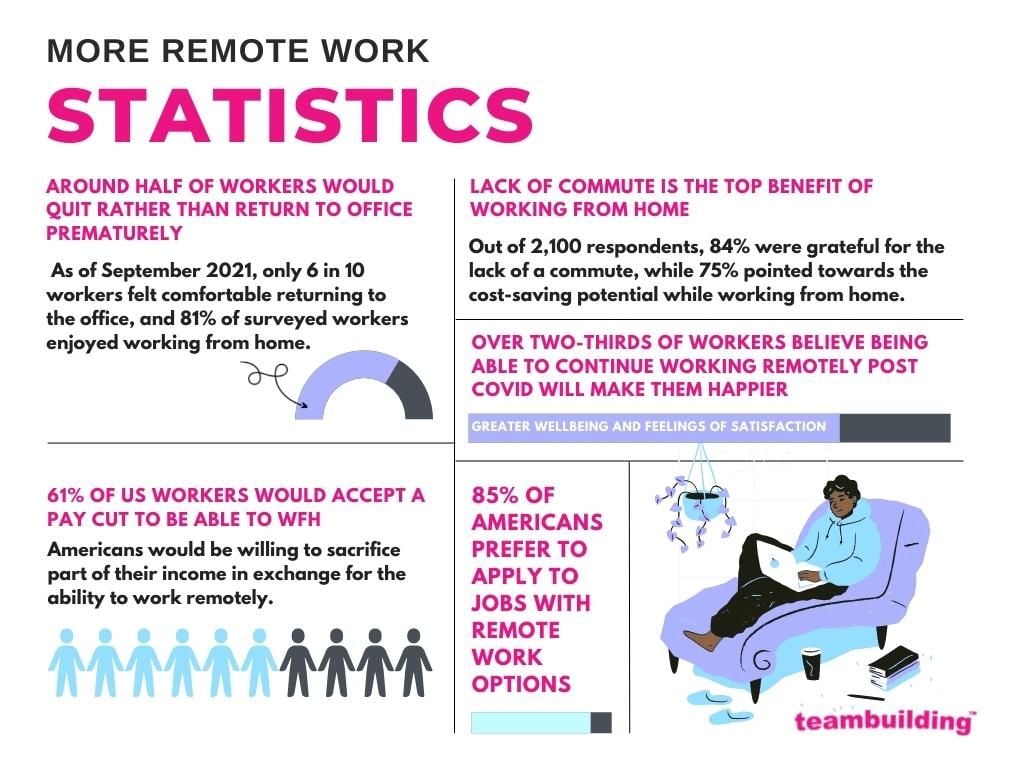
14. Lack of commute is the top benefit of working from home
A recent survey conducted by FlexJobs found that out of 2,100 respondents, 84% were grateful for the lack of a commute, while 75% pointed towards the cost saving potential while working from home.
Other interesting insights from that same survey include:
- 24% of those surveyed had a proper home office, while 34% reported a dedicated “home office space”.
- 37% of respondents would definitely consider relocating if able to secure a permanent remote job.
- 55% of remote workers feel their productivity has improved while working from home, while a minority 6% thinks it has decreased. The remaining are unsure or have seen no performance change.
- 58% would absolutely look for a new job if no longer allowed to work remotely.
Meanwhile, in an Indeed survey that focused more on remote work’s lifestyle benefits, 75% of participants reported that telecommuting improved work-life balance.
Here is an in-depth guide to employee perks and benefits.
15. Over two-thirds of workers believe being able to continue working remotely post COVID will make them happier
Findings from Owl Labs’ 2020 State of Remote Work Report revealed that 77% of respondents believed being able to work remotely at least some of the time would lead to greater wellbeing and feelings of satisfaction.
In the same survey, 23% of workers would consider taking a pay cut of up to 10% for the ability to work remotely on occasion.
16. Working remotely half the week would reduce greenhouse gas emissions to a degree equivalent of taking entire states off the grid
According to estimates from Global Workplace Analytics, if every worker who held a WFH-compatible job worked remotely for half of the week, the decrease in greenhouse gas emissions “would be the equivalent to taking the entire New York State workforce off the road.”
However Bloomberg argues that the overall environmental impact of remote work is less straightforward. While less commuting means less vehicle emissions and empty offices use less resources, employees use more energy at home offices when telecommuting, and often live in suburban areas where emissions are greater. Remote work can be a greener option, however it often requires smart and conscious choices on the part of individual employees, or carbon neutral incentives on the part of employers.
17. Employers could save an average of $22k per remote employee
An article from Forbes claims that average employer savings per remote employee are near $22,000 per year. Experts can link such savings to factors such as reduced overhead and office space and increased productivity. Meanwhile, employees can save an average of $4,000 per year in personal expenses such as gas and commuting costs and takeout lunches.
18. Left unchecked, remote work can decrease collaboration by up to 25%
Research recently published in the journal Nature Human Behaviour revealed that when studying the effects of WFH collaboration in over 6,000 Microsoft employees, cross-team collaboration decreased by a factor of 25%. Workers tended to collaborate more often with strong social ties and less often with looser social ties. As a result, teams were less likely to access new information.
It is worth noting that this was a controlled experiment meant intentionally to study the natural effects of this environment, and there are measures leaders can take to avoid these outcomes. Here are ways to improve team cooperation at work.
19. 77% of workers believe they are more productive when working remotely
A survey from cloud platform CoSoCloud reported that 77% of workers reported being more productive when working remotely, and 52% are less likely to take time off of work, thanks to more flexible working arrangements.
20. Video conferencing software search traffic grew 500% in the first quarter of 2020
Video conferencing platforms are a key remote work tool, and with the sudden shift to remote work caused a dramatic increase in Google Trends search volumes, according to TrustRadius. Similarly, Zoom’s daily meeting participant list grew from a mere 10 million in 2019 to 350 million by the end of 2020, and many other virtual conferencing platforms saw similar growth in user bases. According to a survey from Lifesize, 89% of participants believed that virtual meeting software to lessen the time needed to complete projects, and 98% shared that video meetings helped workers connect with remote colleagues.
Here is a list of virtual meeting platforms and a guide to remote meeting etiquette.
21. Remote workers with communicative employers are 5x as productive and 3x less likely to burnout
Insights gathered from a McKinsey report reveal that employees who received detailed communications from employers were five times more likely to report themselves as being productive. Receiving updates from employers and feeling involved in workplace happenings decreased employee anxiety, whereas employees not kept in the loop about post-pandemic plans for work were almost three times more susceptible to burnout.
One way virtual employees can keep staff in the loop is by holding online town halls. Here is a guide to virtual all-hands meetings.
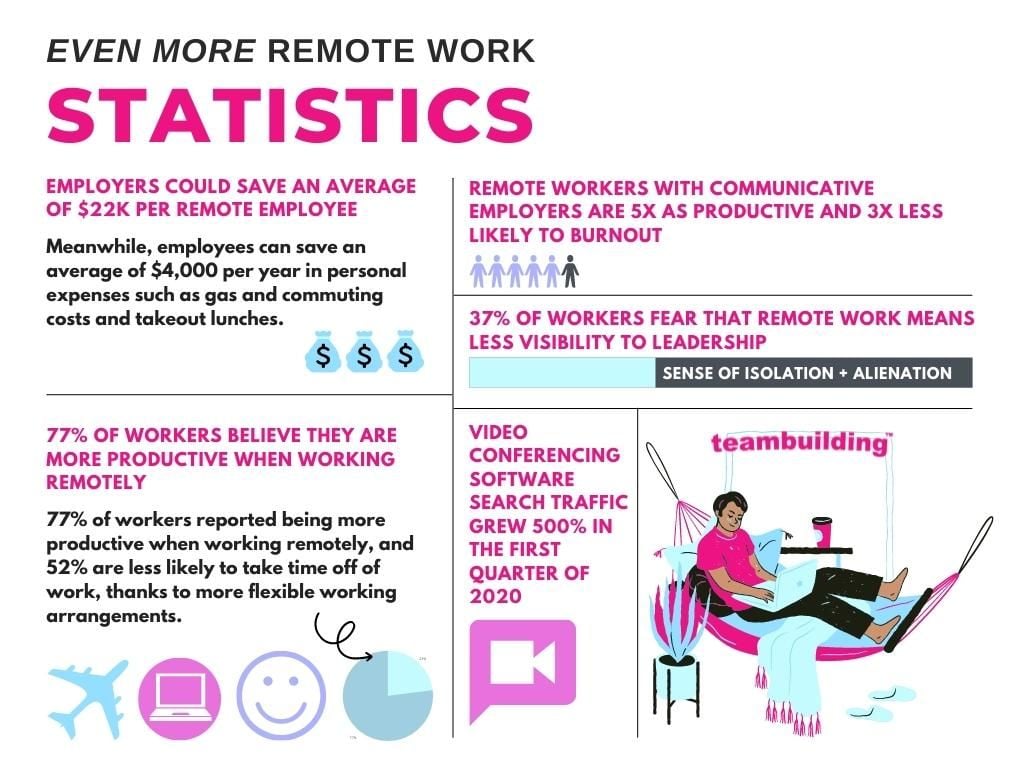
22. 37% of workers fear that remote work means less visibility to leadership
A survey from Indeed found that 37% of remote worker respondents felt that working virtually meant less interaction with, access to, and acknowledgment from higher management. Alienation from coworkers and a sense of isolation and loneliness were also cited as one of the main downsides to remote work.
Here is a list of virtual employee recognition programs that can counteract these circumstances.
23. Over half of executives expect to spend more on remote work tools and virtual manager training in coming years
A survey of remote work by PwC reported that 60% of executives plan to prioritize spending on tools for virtual collaboration and training for remote managers. On the same poll, providing training to managers on leading virtual teams was one of the topics on which employers and employees disagreed on the success of to the greatest extent, second only to extending childcare benefits.
How to cite these remote work statistics
If you use data or statistics from this resource or reshare the infographic, please include a link to https://teambuilding.com/blog/remote-work-statistics.
We will continue updating this resource with useful remote work statistics, facts, and trends.
Next, check out this list of team building statistics, these job satisfaction statistics, these employee engagement statistics, and these staff turnover statistics. We also have a list of quiet quitting statistics.
We also have a guide to team building trends in the workplace and a list of work-life balance ideas.
